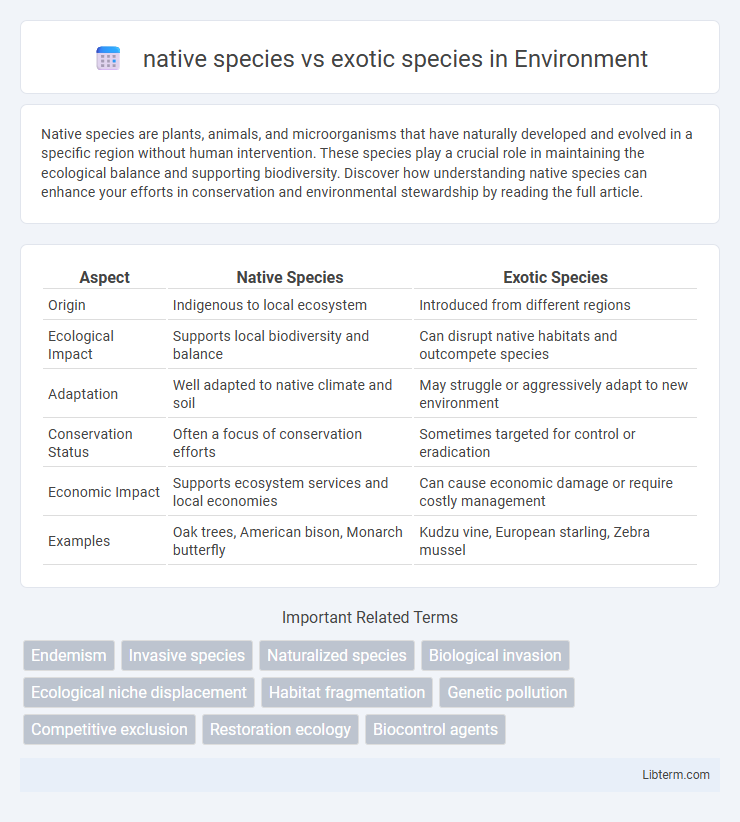Native species are plants, animals, and microorganisms that have naturally developed and evolved in a specific region without human intervention. These species play a crucial role in maintaining the ecological balance and supporting biodiversity. Discover how understanding native species can enhance your efforts in conservation and environmental stewardship by reading the full article.
Table of Comparison
| Aspect | Native Species | Exotic Species |
|---|---|---|
| Origin | Indigenous to local ecosystem | Introduced from different regions |
| Ecological Impact | Supports local biodiversity and balance | Can disrupt native habitats and outcompete species |
| Adaptation | Well adapted to native climate and soil | May struggle or aggressively adapt to new environment |
| Conservation Status | Often a focus of conservation efforts | Sometimes targeted for control or eradication |
| Economic Impact | Supports ecosystem services and local economies | Can cause economic damage or require costly management |
| Examples | Oak trees, American bison, Monarch butterfly | Kudzu vine, European starling, Zebra mussel |
Introduction to Native and Exotic Species
Native species are organisms that have evolved naturally in a specific region or ecosystem, playing a crucial role in maintaining ecological balance. Exotic species, also known as non-native or invasive species, are introduced intentionally or accidentally into new environments where they may disrupt local habitats and biodiversity. Understanding the differences between native and exotic species is essential for effective conservation and ecosystem management strategies.
Defining Native Species
Native species are organisms that have naturally evolved and established populations in a specific geographic region without human intervention. These species have adapted to local environmental conditions over time, playing crucial roles in maintaining ecosystem balance and biodiversity. Understanding native species is essential for conservation efforts, as they contribute to habitat stability and ecological resilience.
Understanding Exotic Species
Exotic species are non-native organisms introduced into new environments where they often lack natural predators, allowing rapid population growth and potentially disrupting local ecosystems. These species can outcompete native flora and fauna for resources, leading to declines or extinctions of indigenous species and altering habitat structures. Understanding the ecological impacts and pathways of introduction of exotic species is crucial for developing effective management and conservation strategies.
Key Differences Between Native and Exotic Species
Native species naturally occur and evolve in a specific geographic area, adapting to its climate, soil, and ecological relationships over time. Exotic species, also known as non-native or invasive species, are introduced to new environments where they often lack natural predators, potentially disrupting local ecosystems and biodiversity. Key differences include their origin, ecological roles, and impact on habitat stability, with native species supporting ecosystem balance while exotic species may cause habitat degradation and competition for resources.
Ecological Roles of Native Species
Native species contribute critically to ecosystem stability by maintaining balanced food webs and supporting nutrient cycling, essential for healthy habitats. Their coevolved relationships with other organisms enhance biodiversity, resilience to disturbances, and natural regeneration processes. In contrast, exotic species often disrupt these dynamics, leading to competition, habitat alteration, and loss of native biodiversity.
Environmental Impacts of Exotic Species
Exotic species often disrupt local ecosystems by outcompeting native species for resources, leading to a decline in biodiversity. They can introduce diseases and parasites unfamiliar to native populations, causing further ecological imbalance. Their presence frequently alters habitat structures, nutrient cycling, and food web dynamics, resulting in long-term negative environmental impacts.
Case Studies: Effects of Exotic Species Invasion
Invasive exotic species such as the zebra mussel in the Great Lakes have caused significant ecological disruptions by outcompeting native species and altering aquatic ecosystems. The introduction of the brown tree snake in Guam led to the near-extinction of several native bird species, demonstrating severe impacts on island biodiversity. Efforts to manage these invasions highlight the importance of early detection and rapid response to protect native species and restore ecological balance.
Biodiversity and Ecosystem Balance
Native species play a crucial role in maintaining biodiversity and ecosystem balance by supporting local food webs and nutrient cycles, while exotic species often disrupt these systems by outcompeting native flora and fauna. The introduction of exotic species can lead to a decline in native populations, altering habitat structure and reducing overall ecosystem resilience. Preserving native biodiversity helps sustain ecosystem services such as pollination, soil fertility, and water regulation essential for environmental stability.
Conservation Strategies for Native Species
Conservation strategies for native species emphasize habitat restoration, protection of natural ecosystems, and controlling invasive exotic species that threaten biodiversity. Implementing genetic diversity preservation and establishing protected areas help ensure the survival of native species in their natural environment. Community involvement and education promote sustainable practices that support native species conservation efforts.
Sustainable Management of Exotic Species
Sustainable management of exotic species involves monitoring ecological impacts to prevent disruption of native habitats and biodiversity loss. Effective strategies include controlled removal, habitat restoration, and public awareness programs that balance economic benefits with environmental health. Prioritizing adaptive management practices supports the resilience of native species while mitigating the spread of invasive exotics.
native species Infographic

 libterm.com
libterm.com